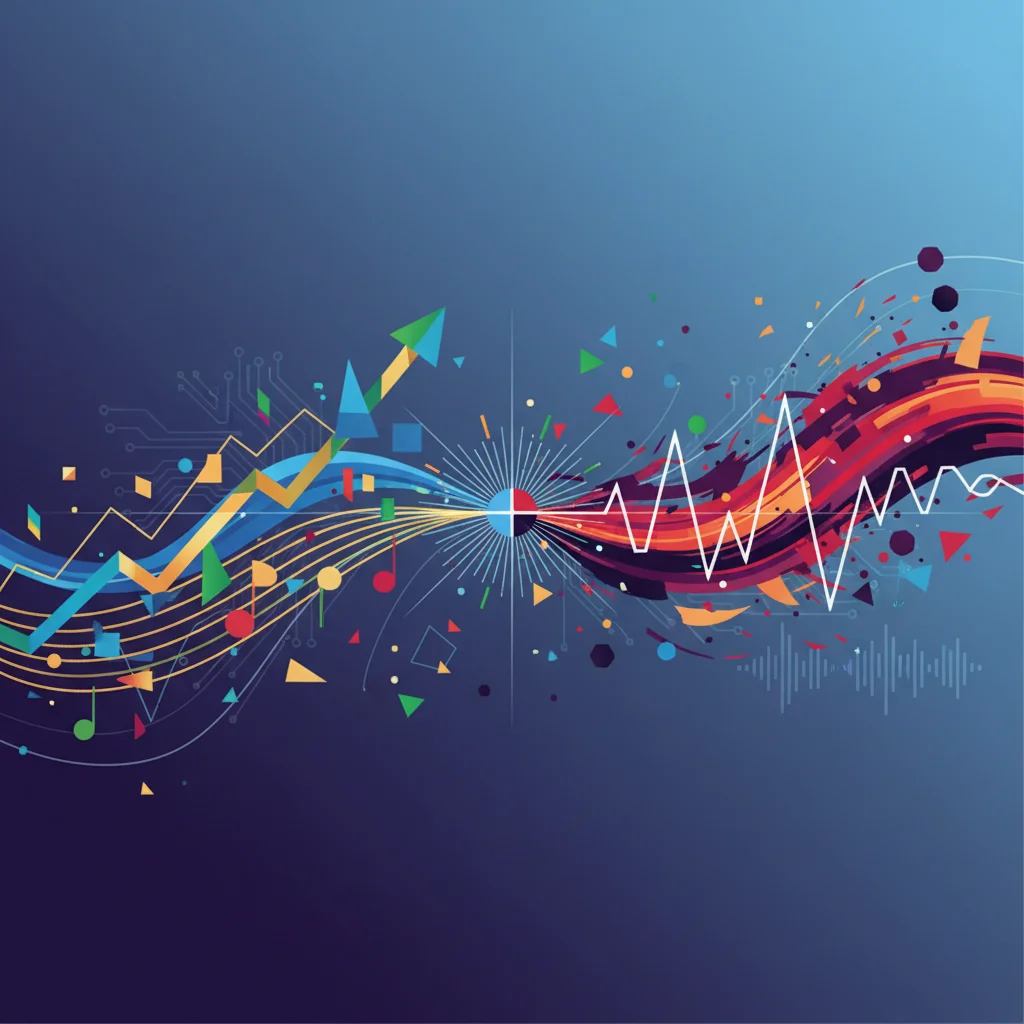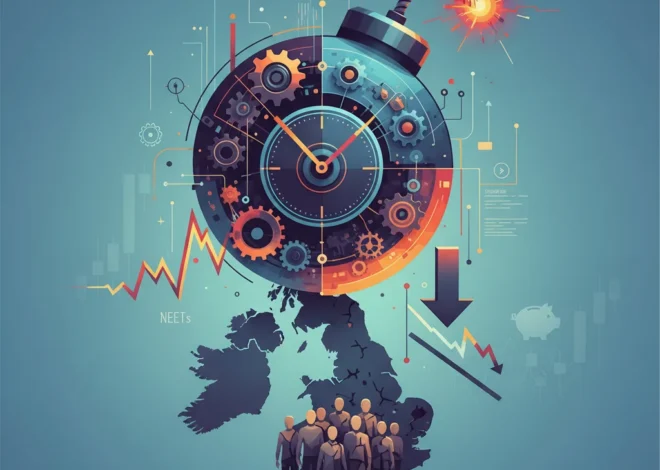
The Investor’s Cadence: What Art and Music Can Teach Us About Market Signals
In a brief but insightful letter to the Financial Times, Jane Williams, an Artist in Residence, described her unique work: she paints in response to music performed live in concerts. “The audience can then view the paintings as they listen,” she explains, highlighting a profound, real-time synthesis of two distinct art forms. This simple, elegant concept of transmuting an auditory experience into a visual one offers a powerful metaphor for the modern world of finance and investing.
Just as Ms. Williams listens for the nuances, tempo, and emotional color of a musical piece to guide her brush, today’s most successful investors must learn to “listen” to the market. They must perceive not just the headline numbers but the underlying rhythms, harmonies, and dissonances of the global economy. The ticker tape is merely the melody; the real story is in the full symphony of data, sentiment, and human behavior. In an era dominated by high-frequency trading and algorithmic precision, the art of interpretation—of being in tune with the paintings of the market—has never been more critical.
The Grand Symphony of the Global Economy
Imagine the global economy as a vast, ongoing orchestral performance. Each section plays a vital role. The powerful brass section might represent industrial and manufacturing output, providing the foundational strength. The soaring strings could be the technology sector—dynamic, fast-moving, and often carrying the main theme. The woodwinds, with their intricate melodies, are the consumer goods and services that add texture and detail to our daily economic lives. And the percussion section? That’s the volatile energy market, driving the rhythm and capable of sudden, dramatic shifts.
In this symphony, central banks like the Federal Reserve or the ECB act as the conductor, using the baton of monetary policy—interest rates and quantitative easing—to guide the tempo. Government fiscal policy writes the core composition. Economic indicators are the sheet music we all read:
- GDP Growth: The overall tempo of the piece—is it an energetic allegro or a sluggish largo?
- Inflation Rates: The dynamics, indicating whether the orchestra is playing at a calm piano or a thundering fortissimo.
- Unemployment Figures: A measure of participation. Is the entire orchestra playing, or are some sections sitting silent?
For decades, the core of financial analysis involved reading this sheet music. But as any musician knows, the notes on the page are only a blueprint. The real music happens in the performance, in the interpretation. The same is true for the stock market. Two investors can look at the exact same economic data and come to wildly different conclusions. The one who succeeds is the one who hears the music, not just the notes.
Nvidia's Trillion-Dollar Handshake: Decoding the AI Megadeals with Asia's Tech Titans
Listening Beyond the Melody: The Art of Finding Alpha
Alpha, the excess return on an investment above a benchmark, is the holy grail for investors. It isn’t found by simply following the main melody that everyone else hears. It’s discovered in the subtle harmonies and counter-melodies that are missed by the crowd. This is where the discipline of economics meets the art of perception.
Modern financial technology, or fintech, has given us extraordinary new “ears” to listen to the market’s hidden sounds. The field of alternative data has exploded, with the global market projected to reach $143.31 billion by 2030, according to a report by Grand View Research. This isn’t your standard earnings report; it’s the market’s subtle feedback loop. It includes:
- Satellite Imagery: Counting cars in a retailer’s parking lot to forecast sales before the company reports them.
- Social Media Sentiment: Using Natural Language Processing (NLP) to gauge public mood about a brand or the economy at large.
– Geolocation Data: Tracking foot traffic to understand consumer behavior patterns.
This is the financial equivalent of Jane Williams feeling the audience’s reaction or the acoustics of the concert hall. It’s the contextual information that gives the primary data its true meaning. An investor who combines a company’s solid balance sheet (the sheet music) with surging positive sentiment online (the music) is far better equipped to make a profitable decision.
Below is a comparison of traditional and alternative data sources, illustrating the expanding toolkit for the modern investor.
| Data Type | Traditional Sources | Alternative (Fintech-Enabled) Sources |
|---|---|---|
| Company Performance | Quarterly/Annual Reports, SEC Filings | Credit Card Transaction Data, Web Scraping, App Usage Statistics |
| Economic Health | Government Statistics (GDP, CPI, Unemployment) | Shipping Port Traffic, Satellite Oil Reserve Imagery, Job Postings Data |
| Market Sentiment | Investor Surveys (e.g., VIX) | Social Media NLP, News Sentiment Analysis, Search Trend Data |
| Asset Valuation | Discounted Cash Flow, P/E Ratios | Patent Filings, Supply Chain Mapping, ESG Data |
Beyond the Bus Stop: Analyzing the Economic Fallout of the UK's Youth Transport Decision
The New Instruments: Blockchain and the Tokenization of Everything
If fintech provides new ways to listen, then blockchain technology is fundamentally changing the instruments being played. At its core, blockchain is a distributed, immutable ledger. In our symphony analogy, it’s like creating a perfect, universally agreed-upon musical score that cannot be altered. This has profound implications for finance and banking, promising to reduce fraud, increase transparency, and streamline transactions.
Nowhere is this more apparent than in the art world itself. The very market that inspired this metaphor is being transformed by technology. Non-Fungible Tokens (NFTs) use blockchain to create verifiable, unique ownership of digital assets, including art. This solves the age-old problem of provenance and authenticity. Furthermore, blockchain enables fractional ownership. Suddenly, a multi-million-dollar painting—an asset class previously reserved for the ultra-wealthy—can be “tokenized” and sold in thousands of digital shares. This democratizes access to alternative investments, allowing a small investor to own a piece of a Picasso in the same way they own a share of Apple.
This trend extends far beyond art. Real estate, private equity, and even venture capital are being tokenized, creating new, liquid markets for previously illiquid assets. This is a fundamental change in the composition of the economic symphony, introducing entirely new instruments and sounds for investors to understand and incorporate into their portfolios.
The Art Market as an Economic Barometer
The art market is not just a useful metaphor; it is a powerful economic indicator in its own right. As an asset class, fine art often has a low correlation with traditional equities, making it a valuable tool for diversification. More importantly, the performance of the high-end art market can serve as a real-time sentiment indicator for the world’s wealthiest individuals.
When confidence among business leaders and high-net-worth investors is high, they are more likely to make discretionary, high-value purchases at auctions. A record-breaking sale at Christie’s can signal a “risk-on” appetite that may precede broader market rallies. Conversely, when auction results are muted and major works go unsold, it can signal underlying anxiety long before it appears in official economic data. The global art market reached an estimated $67.8 billion in 2022, demonstrating its significant economic footprint, as reported by the Art Basel and UBS Global Art Market Report. Monitoring its pulse is another way for savvy investors to listen for the economy’s subtler frequencies.
Conducting Your Own Portfolio: Actionable Insights
How can the average investor, finance professional, or business leader apply these lessons? It’s about cultivating the mindset of both an artist and a scientist.
- Develop Your “Ear”: Don’t confine your information diet to financial news. Read about technology, culture, geopolitics, and science. The next major market shift may be seeded in a cultural trend long before it’s reflected in a P/E ratio. True insight comes from connecting disparate dots.
- Embrace Your Tech-Enabled Tools: You don’t need a hedge fund’s resources to access high-quality data. Many modern brokerage and fintech platforms offer sophisticated tools for analysis, sentiment tracking, and portfolio management. Use them to augment your own research, not replace it. According to a Deloitte report, AI is becoming central to creating personalized and predictive financial services.
- Listen for the Dissonance: The most interesting moments in music—and in markets—are when things seem off. When the stock market is soaring but bond yields are plummeting, or when a company reports record earnings but its stock falls, that’s a dissonance. Don’t ignore it. These are the moments that demand deeper investigation and often hide the greatest risks and opportunities.
The Hidden Capital in Your Utility Bill: Unlocking Dormant Assets in a Digital Economy
Ultimately, the lesson from Jane Williams’ art is one of active, engaged interpretation. She doesn’t just passively hear the music; she processes it and creates something new. In the same way, we must move beyond being passive consumers of financial data. We must become active interpreters of the market’s complex, ever-changing symphony, using both the analytical power of modern technology and the timeless wisdom of human judgment to compose our own masterpiece of financial success.


